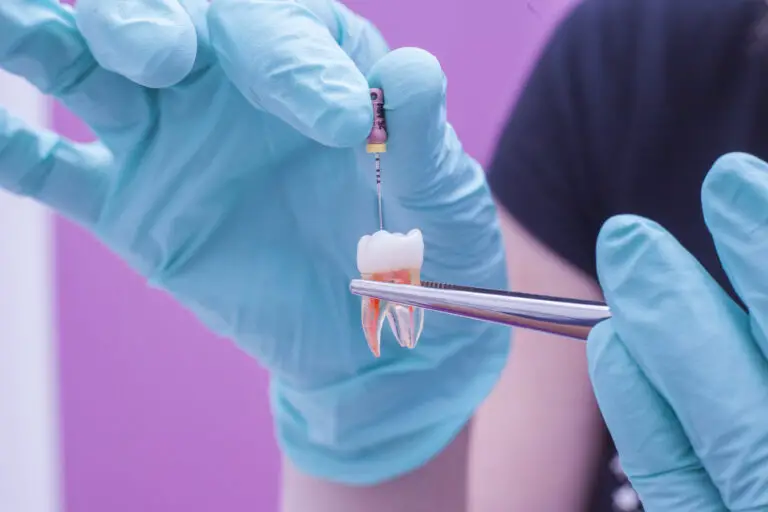Do you have a toothache that won’t go away? Are you wondering if a root canal can save your tooth? Root canal treatment is a common procedure that can save a damaged or infected tooth. However, in some cases, a tooth may be too damaged to be saved by a root canal.
If you’re experiencing severe tooth pain, sensitivity to hot or cold, or swelling in your gums, it’s important to see a dentist as soon as possible. Your dentist can examine your tooth and determine if a root canal is necessary. In some cases, your dentist may recommend other treatments, such as a tooth extraction, if a root canal is not possible.
It’s important to understand the signs that a tooth may not be able to be saved by a root canal. In some cases, a tooth may be too damaged or infected to be treated with a root canal. Understanding the signs can help you make an informed decision about your dental health. Let’s explore the signs that a tooth may not be able to be saved by a root canal.
Understanding Root Canal Therapy

What is Root Canal Therapy?
Root canal therapy is a dental procedure that involves removing the infected or damaged pulp from inside a tooth. The pulp is the soft tissue that contains nerves, blood vessels, and connective tissue. This procedure is also known as endodontic treatment.
During a root canal, the dentist will numb the area around the tooth and create an opening in the top of the tooth to access the pulp. Then, using small instruments, the dentist will remove the damaged or infected pulp from the root canals of the tooth. After the pulp is removed, the dentist will clean and shape the root canals and fill them with a special material to seal them.
Why is it Needed?
Root canal therapy is needed when the pulp inside a tooth becomes infected or damaged. This can happen due to a variety of reasons, including deep decay, a cracked or broken tooth, or repeated dental procedures on the same tooth.
If left untreated, an infected or damaged pulp can lead to a painful abscess, which is a pus-filled pocket that forms at the end of the tooth’s root. The infection can also spread to other parts of the body, causing serious health problems.
Root canal therapy can save a tooth that would otherwise need to be extracted. It is a safe and effective procedure that can relieve pain and restore the function of a damaged tooth.
In summary, root canal therapy is a dental procedure that involves removing the infected or damaged pulp from inside a tooth. It is needed when the pulp becomes infected or damaged, and it can save a tooth that would otherwise need to be extracted.
Signs That a Tooth May Not Be Saved by a Root Canal
If you have a toothache or other dental issues, you may be wondering if a root canal can save your tooth. While root canals are often successful in treating infected teeth, in some cases, a tooth may not be able to be saved. Here are some signs that a tooth may not be saved by a root canal:
Severe Tooth Pain
If you are experiencing severe tooth pain that is not alleviated by over-the-counter pain relievers, it may be a sign that your tooth cannot be saved by a root canal. Severe pain can indicate that the tooth is too damaged or infected to be repaired.
Swelling and Inflammation
Swelling and inflammation around the tooth can also be a sign that a root canal may not be successful. This can occur when the infection has spread beyond the tooth and into the surrounding tissues, making it difficult to treat.
Darkening of the Tooth
If your tooth has become significantly darker in color, it may be a sign that the tooth is dying and cannot be saved by a root canal. This discoloration can occur when the blood supply to the tooth has been compromised due to infection or trauma.
Pus Discharge
If you notice a discharge of pus from the affected tooth, it may be a sign that the tooth is too severely infected to be saved by a root canal. Pus is a sign of an active infection, and if left untreated, it can spread to other parts of the body.
If you are experiencing any of these symptoms, it is important to see your dentist as soon as possible. Your dentist can evaluate your tooth and recommend the best course of treatment to save your tooth and prevent further complications.
Role of Dental Examination

When it comes to determining whether a tooth can be saved by a root canal, a thorough dental examination is critical. During this examination, your dentist will evaluate the tooth and surrounding area to determine the best course of action.
X-Ray Analysis
One crucial aspect of the dental examination is X-ray analysis. An X-ray can help identify the extent of the damage to the tooth and surrounding tissues. It can also help determine whether there is an infection present and how severe it is. In some cases, a CT scan may be necessary to see how severe the infection is and whether it has spread to other areas within your neck.
Physical Examination
In addition to X-ray analysis, your dentist will also perform a physical examination of the tooth. They will check for any visible signs of damage, such as cracks or chips. They will also evaluate the tooth’s sensitivity to hot and cold temperatures and pressure. If the tooth is severely damaged or infected, it may be painful to the touch.
Based on the results of the dental examination, your dentist will be able to determine whether a root canal is a viable option for saving the tooth. If the damage or infection is too severe, the tooth may need to be extracted. However, if caught early enough, a root canal can often save the tooth and prevent further damage or infection.
In summary, a dental examination is a critical step in determining whether a tooth can be saved by a root canal. X-ray analysis and physical examination are both essential components of this examination, allowing your dentist to evaluate the extent of the damage or infection and determine the best course of action.
Alternatives to Root Canal Therapy
If you have a damaged tooth that can’t be saved by a root canal, there are still a few options available. The most common alternatives are tooth extraction and dental implants.
Tooth Extraction
If your tooth can’t be saved, your dentist may recommend extraction. During this procedure, the tooth is removed from the socket in the jawbone. This is typically done under local anesthesia, and you may experience some discomfort afterwards. Your dentist will provide you with instructions on how to care for the extraction site as it heals.
Dental Implants
Dental implants are a popular alternative to root canal therapy. This involves placing a small metal post into the jawbone, which serves as a replacement for the tooth’s root. A crown is then attached to the post, which looks and functions like a natural tooth.
Dental implants are a permanent solution, and they can last for many years with proper care. They also offer several advantages over other tooth replacement options, such as bridges and dentures. For example, they don’t require any special maintenance, and they don’t put any strain on the surrounding teeth.
While tooth extraction and dental implants are both viable alternatives to root canal therapy, it’s important to discuss your options with your dentist. They can help you determine which option is best for your specific situation, taking into account factors such as the location of the tooth, your overall oral health, and your budget.
Remember, the best way to avoid needing alternatives to root canal therapy is to practice good oral hygiene and see your dentist regularly for checkups and cleanings.
Frequently Asked Questions
When is a tooth beyond saving with a root canal?
A tooth can be beyond saving with a root canal if it has extensive decay or damage that cannot be repaired. Additionally, if the tooth has a severe infection or abscess, it may not be possible to save it with a root canal.
What are the signs that a root canal has failed?
Signs that a root canal has failed include persistent pain, swelling, and tenderness in the affected tooth and surrounding area. You may also notice a recurring pimple on the gum near the affected tooth. If you experience any of these symptoms, it is important to see your dentist as soon as possible.
Can a tooth still be saved if a root canal fails?
In some cases, a tooth may still be saved even if a root canal has failed. Your dentist may recommend additional treatment, such as an apicoectomy or retreatment of the root canal. However, in some cases, the tooth may need to be extracted.
What are the alternatives to a root canal for a severely damaged tooth?
If a tooth is severely damaged and cannot be saved with a root canal, the alternatives may include extraction or a dental implant. Your dentist can discuss the pros and cons of each option with you to help you make an informed decision.
Is it possible to prevent root canal failure?
While there is no guarantee that a root canal will be successful, there are steps you can take to reduce your risk of root canal failure. These include maintaining good oral hygiene, avoiding hard or sticky foods, and seeing your dentist regularly for checkups and cleanings.
How can a dentist determine if a tooth cannot be saved with a root canal?
Your dentist will typically use X-rays and other diagnostic tools to assess the extent of the damage to the affected tooth. Based on this information, they can determine whether a root canal is a viable option or whether the tooth needs to be extracted.







